This website uses cookies for a better browsing experience.
If you agree to the use of cookies, please click the "Agree" button.
Please refer to the Privacy Policy regarding the use of cookies on this site.

We endorse the TCFD.
Features
We have established the Sustainability Promotion Council as the body for discussing sustainability issues such as climate change. Chaired by the president and attended by all directors and auditors, the Sustainability Promotion Council convenes twice a year to deliberate on formulating Oiles Group policies and targets to respond to climate change-related risks and opportunities.
Established under the umbrella of the Sustainability Promotion Council is the Sustainability Committee, which is chaired by the officer in charge of sustainability. The Sustainability Committee reports on the status of initiatives addressing sustainability issues such as climate change to the Sustainability Promotion Council.
We are addressing climate change through this multi-tiered organizational structure, and the Board of Directors additionally exercises oversight over climate change-related risks and opportunities.
Governance System for Climate Change Issues
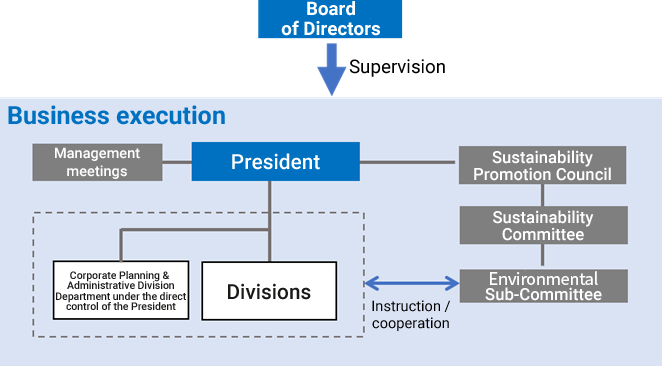
Sustainability Promotion Council
- Structure
Chairperson: President
Attendees: Directors, auditors, operating officers
Administrative organization: Sustainability Promotion Office of the General Affairs Department - Frequency
Twice a year (September and March) - Main agenda
Discuss sustainability issues to contribute to medium- to long-term corporate value improvement - Other
Operated from FY2018
Strategy
Scenario
We identify risks (migration risks and physical risks) and opportunities brought about by climate change based on the recommendations of the Task Force on Climate-related Financial Disclosures (TCFD). We use the 2°C scenario to analyze transition risks and the 4°C scenario to analyze physical risks.
The applicable time period is 2030, the final fiscal year of the Sustainable Development Goals (SDGs) for the medium term and 2050 for the long term.
| The Environment Surrounding the Oiles Group (Risks & Opportunities) | |
|---|---|
| 2°C scenario | In addition to increasing demands from customers, investors, and other stakeholders for initiatives aimed at achieving carbon neutrality (lower carbon economy), stronger legal regulations such as introducing carbon taxes are also expected. The need for technological innovation will become urgent in all industries, not just the automotive industry, where electrification is already underway. → Transition risks emerge, as well as opportunities to deal with them |
| 4°C scenario | This is a scenario in which the above initiatives are not implemented. Transition risks are limited, but major disasters will occur due to extreme weather events caused by rising temperatures (wind and flood damage caused by sudden weather events and long-term wind and flood damage caused by changing climate patterns). In addition to soil erosion resulting from rising sea levels, the stability of water sources and employee health will also be impacted. → Physical risks emerge, as well as opportunities to deal with them |
Risk
Main Transition Risks
| Impact / Time frame | Countermeasures | |
|---|---|---|
| Removal from customer supply chains due to slow action to address climate change | Significant / medium- to long-term |
|
| Loss of earning opportunities due to slow development of eco-friendly products | Significant / medium- to long-term |
|
| Loss of market due to innovative changes in raw materials required for products | Significant / medium- to long-term |
|
| Introduction of carbon taxes | Intermediate / long-term |
|
Main Physical Risks
| Impact / Time frame | Countermeasures | |
|---|---|---|
| Damage to plant facilities caused by rivers flooding due to record-breaking wind and water disasters | Intermediate / long-term *Low likelihood of occurring |
|
| Negative impact on employee health and productivity caused by rising average temperatures | Intermediate / long-term |
|
Opportunity
Main Opportunities
| Impact / Time frame | Countermeasures | |
|---|---|---|
| [Bearing equipment business and architectural devices business] Creating and growing new demand by developing products and technologies that contribute to CO₂ emission reduction |
Significant / medium- to long-term | [Bearing business]
|
| [Structural devices business] Trend toward strengthening resilience in the infrastructure sector, including bridges, related to the prevention and mitigation of disasters and carrying out of restoration work |
Significant / medium- to long-term | [Structural devices business]
|
Risk Management
The Sustainability Promotion Council, chaired by the president and attended by all directors and auditors, assesses and identifies risks related to climate change issues based on reports from the Sustainability Committee and decides the overall direction for management. In addition, we established the Environment Sub-Committee under the umbrella of the Sustainability Promotion Council and Sustainability Committee as the administrative organization for addressing climate-related risks. The General Manager of the Quality Assurance & Environmental Safety Department heads the Environment Sub-Committee. In light of the risks and opportunities involved, we are pressing forward with measures to address climate change issues, with a particular focus on reducing CO₂ emissions.
The status of our efforts to address climate-related risks is regularly reported to management via the following process: Environment Sub-Committee → Sustainability Committee → Sustainability Promotion Council. Furthermore, the BCP/BCM Sub-Committee under the Sustainability Promotion Council and Sustainability Committee also follows up on the physical risk of flooding caused by climate change. However, the possibility of its occurrence is low.
The Risk Management Sub-Committee is also positioned under the Sustainability Promotion Council and Sustainability Committee. Headed by the General Manager of the Legal Department, the Risk Management Sub-Committee regularly reports to management meetings (also attended by outside directors) on the overall picture of risks that the Oiles Group should be aware of, including climate change risks.
Oiles Group CSR (ESG) Management System
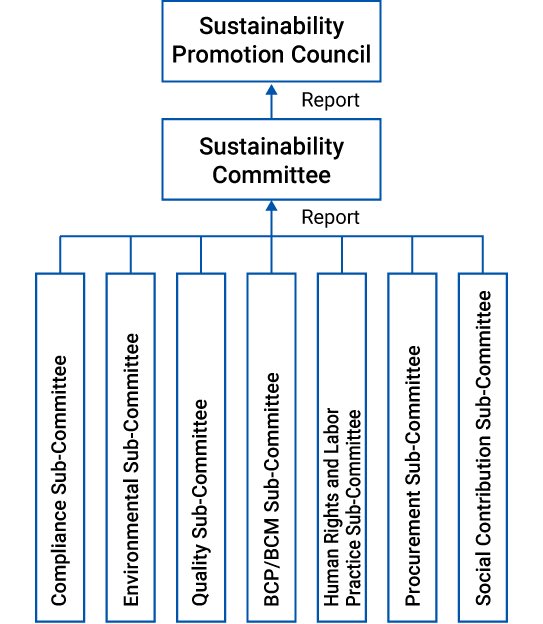
Indicators and Targets
In 2023, we once again revised our environmental targets, which we previously revised in 2021, in order to achieve carbon neutrality by 2050. We have divided our recently revised environmental targets into two steps, with the first step being reducing total CO₂ emissions by 46% from their level in FY2013 by FY2030 and the second step being eventually achieving carbon neutrality by 2050. In this second step, the Oiles Group as a whole seeks to achieve carbon neutrality by 2050.
Environmental Targets
(1) Step 1: Reducing total CO₂ emissions by 46% their level in FY2013 by FY 2030
(2) Step 2: The Group as a whole will achieve carbon neutrality by 2050
*This includes Scope 1 and Scope 2
Oiles Group CO₂ emissions (Scope 1, Scope 2)
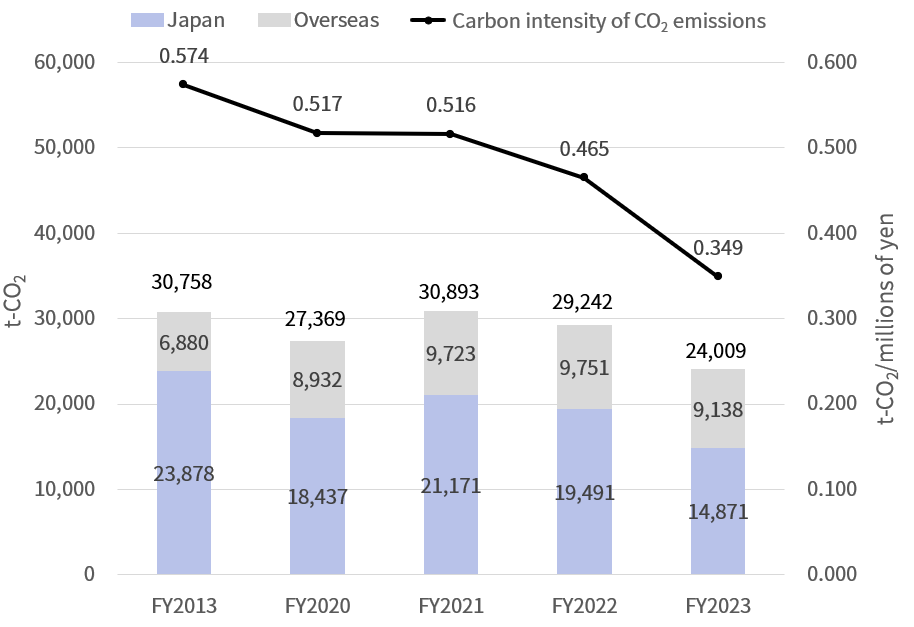
Reference: Oiles Group supply chain CO₂ emissions
| Category | FY2021 CO₂ emissions (t-CO₂) |
FY2022 CO₂ emissions (t-CO₂) |
Ratio of FY2022 total (%) |
|
|---|---|---|---|---|
| Scope1 | Our direct CO₂ emissions | 7,180 | 7,435 | 4 |
| Scope2 | Our direct CO₂ emissions | 23,713 | 21,808 | 12 |
| Sum of Scopes 1 & 2 | 30,893 | 29,242 | 16 | |
| Scope3 | 1. Purchased products & services | 111,923 | 124,696 | 68 |
| 2. Capital goods | 10,868 | 8,631 | 5 | |
| 3. Fuels, etc., not included in Scopes 1 & 2 | 5,274 | 5,349 | 3 | |
| 4. Transportation & deliveries (upstream) | 12,846 | 12,233 | 7 | |
| 5. Emissions from businesses | 1,301 | 1,144 | 1 | |
| 6. Business travel | 265 | 264 | 0 | |
| 7. Employee commuting | 1,127 | 913 | 1 | |
| Sum of Scope 3 | 143,605 | 153,230 | 84 | |
| Total supply chain emissions | 174,498 | 182,473 | 100 | |
*The CO₂ emissions of the Oiles Group (Scope 1, Scope 2, and Scope 3) have received independent assurance from the Sustainability Accounting Co., Ltd.
Status of Efforts to Reduce CO₂ Emissions
Under the auspices of the Sustainability Promotion Council, the Environmental Sub-Committee promotes our efforts to achieve environmental targets in cooperation with our production sites.
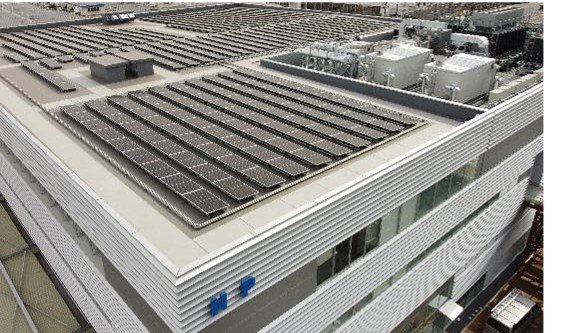
Solar power generation at the Fujisawa Plant
We have mostly completed the conversion to LED lighting at our domestic plants and we are systematically upgrading to energy-efficient air conditioning and production equipment. As a first for us, our Fujisawa Plant has been generating solar power with its own solar panels since December 2021. In FY2022, we began procuring renewable electricity and we also installed equipment to more precisely gauge the amount of electricity used in product manufacturing.
Raising the awareness of each and every employee is also important to achieving our environmental targets. In addition to working to reduce energy loss and defects at our production sites and continuing to educate employees on environmental issues through training, we have made devising “environmental approaches” a mandatory item on the annual plans of each department since FY2023 to raise awareness of environmental approaches. Based on visually presented data, the office of the Environmental Management Committee at the Fujisawa Plant notifies each workplace of its energy consumption on a monthly basis, and it encourages workplaces using large amounts of energy to voluntarily identify reasons for that use and to reduce that use by comparing energy use to the previous year and by comparing those workplaces to other workplaces.
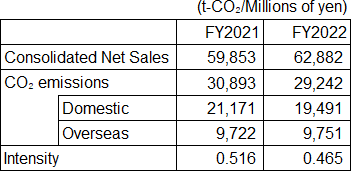
Consolidated net sales in FY2022 increased 5.1% from the previous fiscal year, but, the Group’s total CO₂ emissions in FY2022, including at sites overseas, were 29,242 t-CO₂, a 5.3% decrease from the previous fiscal year, as a result of our efforts to reduce CO₂ emissions. In addition, carbon intensity (CO₂ emissions per unit of energy) was 0.465 t-CO₂/million yen, which was lower than that in the base year of FY2013. Moreover, the CO₂ emissions of our domestic production sites in FY2022 were 19,491 t-CO₂, a 7.9% decrease from the previous fiscal year.
In order to achieve our plan for 2030 (Step 1), we will promote various measures in Japan and overseas, including further promotion of reduced energy use company-wide, further upgrading to more energy-efficient facilities, and increasing the ratio of renewable electricity procured.
To achieve our target of becoming carbon neutral by 2050 (Step 2), we need to review energy procurement company-wide, implement energy-efficient production lines, and fundamentally review our methods of production. To provide products and technologies that help solve the world’s problems, we will “tirelessly pursue technologies” to create innovation for our Group to achieve carbon neutrality by 2050.



